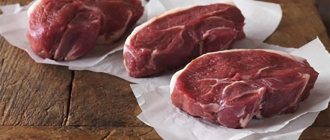Most young housewives have a number of questions. How long can you store meat in the freezer? How to properly package meat products to preserve their beneficial properties and taste? At what temperature should you store meat? Let's try to figure out all the unclear points.
Source: depositphotos.com
Meat goes on sale:
- Chilled. The temperature of such a product is maintained within 0…+4 ºC. Chilled meat can be stored in the refrigerator for no more than 24 hours.
- With freezing no more than 25% of the total volume. The shelf life of meat increases to 15 days, but in household freezers it is almost impossible to achieve suitable conditions for storing a frozen product.
- Frozen. At subzero temperatures, most microorganisms in meat products do not develop, so you can safely store meat frozen for more than a month.
Not all household refrigerators are equipped with a function for adjusting the temperature in the freezer compartment. Typically, this parameter has a constant value of −18…−24 ºC (depending on the model of the refrigerator). That is why there is no other way to store meat for a long time at home, other than complete freezing.
The importance of safe meat storage
Safe storage can protect meat from loss of quality and flavor, as well as bacterial growth. Storing meat safely in the freezer at -18°C inhibits the growth of most bacteria. Higher temperatures can allow bacteria to grow on meat.
Proper freezing protects against pathogenic bacteria that cause food poisoning. Safe storage also protects meat from loss of taste and quality. A number of compounds in meat oxidize and break down quite quickly at room temperature, which affects the taste. Proper storage methods—such as drying, smoking, and freezing—can slow this process or prevent some loss of quality.
Meat freezing methods
During the freezing process, the characteristics of muscle tissue change, which is explained by the transformation of water into ice. The quality of the semi-finished product after thawing depends on how it is cooled to negative temperatures. The following freezing methods are known:
- Domestic.
The cut, steaks or minced meat are placed in the freezer compartment of the refrigerator. - Industrial.
Meat and poultry producers use several freezing technologies. These include immersion in liquid coolants, contact technique (clamping between plates with a coolant), and air freezing. The latter option is carried out using stationary standard chambers, quick freezers, as well as blast freezing chambers.
Air freezing is the most versatile and effective. Air plays the role of an intermediate coolant, transferring cold from the evaporator in the desired direction.
Recommendations for storing and freezing meat
Preparing meat for freezing
In most cases, you can store meat purchased at the market in the packaging in which it was sold. First check for holes or tears in the packaging, sealing the packaging will keep the meat safe at the recommended temperature.
For dressed meat, wrap the pieces in an airtight container. It is recommended to wrap the package in foil or plastic wrap if the meat will be stored for more than 2 months.
Freezing point
Freezing point is a critical aspect of meat storage. Meat should be stored frozen at temperatures below -18°C. This temperature inhibits the growth of bacteria and any other microorganisms such as yeast and mold. Some freezers that are used frequently may not reach such low temperatures consistently, which can expose food to the risk of bacterial growth and spoilage.
Defrosting meat
There are three main methods for defrosting and thawing meat from the freezer.
The slowest and perhaps safest method is to defrost the sealed package in the refrigerator. Small pieces of meat may take a few hours to defrost, while large pieces of meat may take several days to defrost.
To quickly defrost meat, you can place a sealed plastic bag in a bathtub of cold water. Some microwave ovens also have special settings for defrosting frozen meat. If using the microwave method, cook the meat immediately after defrosting.
Never defrost meat outdoors at room temperature, such as on the kitchen counter or in the sink. Bacteria can multiply quickly at room temperature.
Re-freezing meat
Once raw meat has been thawed properly, many experts recommend not refreezing it. This is mainly to prevent loss of texture and quality.
Raw meat thawed in the refrigerator is safe to refreeze, although quality may suffer due to moisture loss. When thawing and refreezing meat, ice crystals form in the meat, which rupture the tissue of the meat at a microscopic level, which can change the taste and texture of the meat.
Thawing and refreezing meat can cause noticeable differences in quality. The meat can be very dry.
This concerns us all.
Still from the film “The Butcher”
If you're like most guys, you've probably returned from the store and thrown a package of chicken breasts into the freezer; then, when you want to cook them, you defrost the meat in the microwave or just on the table and worry little about whether it’s right or not.
But it turns out there is a better (and smarter) way to freeze and thaw your seafood, poultry and meat that will not only save time and effort, but also reduce your chances of getting food poisoning.
And since frozen meat is, although not a sexy, but everyday thing, we suggest getting acquainted with what you need to know about it.
How long can you freeze meat?
Freezing meat at -18°C will preserve it indefinitely. However, prolonged freezing can cause noticeable changes in the quality and taste of meat. As a result, different types of meat have different shelf life.
Freezing meat depending on its type:
Fresh meat has the longest shelf life and can last the longest in the freezer without losing quality.
- Raw minced meat: 3-4 months
- Raw ground turkey: 3-4 months
- Steak: 6-12 months
- Roast: 4-12 months
- Chops: 4-6 months
- Liver, tongue, tripe: 3-4 months
- Bacon: 1 month
- Raw sausage: 1-2 months
- Poultry such as chicken or turkey: 12 months
- Offal: 3-4 months
- Lean fish: 6-8 months
- Oily fish: 2-3 months
- Fresh shellfish and squid: 3-6 months
Refreezing cooked meat can also ruin the flavor of the meat, as some flavors oxidize and break down after cooking—even in the freezer.
- Hot dogs: 1-2 months
- Boiled meat: 1-2 months
- Ham: 1-2 months
- Corned beef: 1 month
- Smoked sausages: 1-2 months
- Leftover meat from beef, veal, lamb and pork: 2-3 months
- Gravies, meat broths and stews containing meat: 2-3 months
- Cooked poultry, such as chicken or turkey: 4 months
- In sauce: 6 months
- Roasted: 4 months
- Nuggets and cutlets: 1-3 months
- Boiled fish: 4-6 months
- Smoked fish: 2 months
- Canned fish (from a can): 2 months
Household freezing and its disadvantages
When loaded into a home freezer, the meat cools slowly, during which time the moisture has time to turn into large ice crystals, tearing the muscle fibers. During subsequent defrosting, a significant portion of the liquid flows out from the torn fibers.
. As a result, the meat dish turns out tough and tasteless. Therefore, if you want to buy marbled beef 4-5 days before cooking, you should not freeze it. It is better to wrap the product in a cotton towel (it will have to be changed daily) and place it in the zero zone of the refrigerator. The fabric will absorb excess moisture and prevent the meat from spoiling or drying out. In addition, a “ripened” steak will become softer and more flavorful.
If meat is purchased for longer storage, it is frozen so that the structure is minimally damaged:
- Blot the cut with a paper towel.
- The veins and excess fat are cut off, and the steaks are cut to the desired size and thickness.
- Portions are placed on a board covered with parchment and put into the freezer for 3-4 hours.
- After superficial “setting,” the pieces are transferred to vacuum bags or wrapped in cling film. In a film casing, steaks will freeze quickly and evenly. It prevents them from becoming covered with a crust of snow and the appearance of white spots - cold burns - after thawing.
- A sticker indicating the date is placed on the package. Meat frozen by household methods is stored for no longer than 3 months.
Subsequent defrosting
For meat to be tasty , it needs to be defrosted correctly. Heating devices such as a microwave will definitely ruin the product. Thawing it in water is also not advisable; a lot of nutrients pass into it. Defrosting should take place under natural conditions. It is better to place meat on the bottom shelf of the refrigerator, just like chilled meat, and keep it away from prepared foods.
In case of power outages, you need to be alert. A power outage lasting up to 3 hours will not harm the meat in the freezer. If the process takes a long time, it is better to take it out, remove all the bags and treat it with vinegar to prevent the formation of bacteria. Then place in the coolest place.
If you monitor the contents of the freezer and perform simple manipulations before placing meat products in it, then an unpleasant odor, which usually spreads throughout the entire refrigerator, will not appear. Fresh and tasty dishes are always more pleasant to eat than stale foods that are harmful to health .
Traditional methods of preserving meat products
That's right - but you can freeze eggs! And even necessary!
Just like stewed meat, boiled meat can be stored for two to three days after cooking. In order for the products to last longer, use:
- a bowl with a lid;
- lemon juice;
- Apple vinegar;
- wet cloth with salt.
If you sprinkle boiled meat with lemon juice, it will stay on the shelf for 1 day longer. You can also moisten a cloth with a strong saline solution and wrap the prepared pieces with the material - then they can be stored in the refrigerator for up to 4 days. Shelf life can be increased using any of the methods described above - the product will last longer.
Sometimes it is not necessary to freeze a fresh slice if you need to use it in a couple of days.
According to a folk recipe, a piece can be preserved longer if you fill it with cow's milk. In this case, the storage time increases by a couple of days.
Have you tried soaking meat in milk before? Poll Options are limited because JavaScript is disabled in your browser.
It is important to know how long fresh and cooked beef can be stored in the refrigerator, and how to properly care for the product
How to choose the right one
When choosing minced meat in a store, you should pay attention to 4 main indicators: the presence of juice, consistency, smell and color.
Some of them, alas, cannot be checked if it is sold in a closed original package.
Color
Most types of minced meat and poultry have a delicate pink color. The exception is the product made from horse meat and beef - it has a more pronounced red tint. If the minced meat is gray or greenish, you should not purchase it.
Consistency
Minced meat and fish should be soft and knead well with your hands. If there is excessive dryness and it looks crumbly, this indicates that it has been on the counter for a long time. Such a product has simply dried out and weathered and may already have the first signs of deterioration.
Juice
Fresh minced meat should not have a lot of moisture or blood. If juice begins to appear in it, this indicates that the product was prepared quite a long time ago, or that low-quality raw materials were used in its production. The exception is minced fish, which, on the contrary, should have a small amount of moisture.
Smell
Minced meat and fish should smell pleasant. The presence of notes of acid, chlorine or other chemical elements in the smell may indicate that it was prepared from rotten meat, in which they tried to hide notes that indicate spoilage.
Which meat to choose?
To pleasantly surprise your loved ones, you can buy halal meat or semi-finished products in bulk. They have unsurpassed quality, and their pleasant aroma conquers even the most demanding gourmet. The peculiarity of such products is that animals eat only healthy food throughout their lives. They are also slaughtered by cutting the artery, from where all the blood flows out. It does not get into the meat, due to which its shelf life increases. Halal beef, lamb, and poultry are delivered in bulk to retail outlets immediately after slaughter.
Helpful advice! To prevent white spots from appearing during defrosting, you can brush the meat with olive oil. But its shelf life is no more than 3 months.
Chilled version
Raw meat can sit for some time before freezing. Veal and pork can survive for two days at temperatures from 0 to -3 degrees. Chilled chicken or rabbit carcass can be stored for the same amount of time under the same conditions. But if you use a regular refrigerator with a small plus inside or the pieces are finely chopped, then only 24 hours.
It is better to remove all packaging elements (film, backing) during storage to avoid the formation of an unpleasant odor. Transfer the meat to a glass or plastic container with a lid, but leave a small gap for air exchange. The chilled product has a place on the lowest shelf of the refrigerator, where there are no other ready-made dishes.
The situation with minced meat is like this: any chilled semi-finished product will be fresh for about a day. Longer storage will ruin the dish, so don’t delay cooking or freezing. Additives in the form of onions, eggs, etc. reduce the storage time of minced meat to 4-5 hours. It is better to close the container with it tightly.
Deadlines according to SanPiN
If it is necessary to increase the storage time of meat, it is frozen, but this technique reduces the taste and nutritional value of the product, and also has other disadvantages:
- weight loss;
- dehydration of meat;
- product porosity.
Since all meat products are classified as perishable, they require certain maintenance conditions and strict adherence to storage periods. To prevent food poisoning, you need to know the time during which meat can stay in the freezer without spoiling.
The duration of storage and conditions are determined by the recommendations that are presented in the letter of the Main State Trade Inspectorate of the RSFSR No. 23-1-6/52N dated July 21, 1987. Thus, the storage periods recommended by SanPiN are indicated in the table.
| View | Freezer temperature | Allowable storage period, months |
| Beef | -12̊ C | 8 |
| -18̊ C | 12 | |
| -20̊ C | 14 | |
| -25̊ C | 18 | |
| Pork | -12̊ C | 6 |
| -18̊ C | 10 | |
| -20̊ C | 11 | |
| -25̊ C | 12 | |
| Mutton | -12̊ C | 3 |
| -18̊ C | 6 | |
| -20̊ C | 7 | |
| -25̊ C | 12 | |
| Chicken | -12̊ C | 4 |
| -18̊ C | 7 | |
| -30̊ C | 12 |
In addition to maintaining a certain temperature when storing frozen meat, it is also necessary to monitor other indicators. Thus, the relative humidity should not be lower than 85%. Air circulation is also necessary for proper storage - there should be 4-6 air volumes per hour (this parameter depends on the model of the household refrigerator).
What happens to the product over time
Exposure to frost inevitably leads to the following changes:
- loss of moisture, which means dryness;
- fiber rupture;
- soaking in the smell of the freezer;
- protein destruction;
- darkening of color.
All this reduces the culinary value. It is better to twist such pieces into minced meat and season them with spices - this will help improve the situation.
How to tell if meat has gone bad
Signs of an expired product that is unfit for human consumption:
- sharp unpleasant, repulsive odor;
- slippery surface;
- white or yellowish coating on the surface;
- lack of elasticity;
- damaged packaging or missed expiration date;
- dull red color with a greenish tint.
After the expiration date, but in the absence of signs of spoilage, the meat can be boiled for 2-3 hours and given to pets.
Where should frozen meat be stored?
Where should frozen meat be stored ? To do this, you can use zipper bags. Divide the meat into pieces and put it in a bag, do not forget to release all the air. The quality of your workpiece after defrosting will depend on this.
If you want to freeze chops or steaks, it's best to place a piece of plastic wrap between the individual slices to keep them from freezing. This will make them juicier while baking/frying. Finally, you can close a regular plastic bag using a clamp.
Avoid refreezing meat as this will reduce its taste and texture.
Store salted and dried fish in the refrigerator
Dried fish:
* Dried fish can be stored for quite a long time, since the salt used in its preparation plays the role of a preservative.
*Use thick wrapping paper to wrap the dried fish, then place the fish in a dry, cool place out of direct sunlight.
*If you don't have wrapping paper, you can use a tin or glass jar, which must be covered with a lid.
* In hot weather, it is better to keep fish in the freezer so that it lasts longer.
If you properly dry the fish and then store it according to the above rules, then it will be able to retain its taste for a whole year.
Helpful advice:
Do not wrap fish in newspaper as the printing ink used to print words and images contains lead.
Salty fish:
You can salt the fish at home or buy already salted fish. Moreover, in the store you can find different varieties of such fish.
If you want to keep salted fish longer, store it in brine. The shelf life depends on the amount of salt you use during preparation.
Can meat go bad in the freezer?
In fact, frozen meat does not spoil. Nevertheless, even in a frozen state, some changes occur in the composition of meat - denaturation of proteins (destruction of the natural structure), changes in lipids (fats) and color of the product, and a decrease in weight. These changes are the result of the effects of ice crystals on muscle fibers. An important point is the freezing speed - the higher it is, the less negative the effect of ice crystals on the structure of the meat.
Meat protein, which is stored frozen for up to one year, changes slightly, and biochemical processes are inhibited. This statement does not apply to enzymes, since they are active even at temperatures below -20̊ C.
The changes that occur in a frozen product are called hydrolysis (decomposition of meat fibers under the influence of water) and oxidation. The speed of the process depends on the volume of fatty acids and the contact of the product with oxygen. It is because of this that it is better to vacuum meat for freezing.
Any types of meat and offal if frozen remain edible for a long time. Harmful microorganisms, under the influence of low temperatures, slow down their own vital functions and do not lead to spoilage of the product. It must be remembered that even frozen meat has certain expiration dates, which are not recommended to be exceeded, since the product deteriorates, it loses its original qualities, becomes insipid, dry and porous.
Video: how to freeze meat correctly
How to properly freeze meat. Little home tricks. Live healthy!
Watch this video on YouTube
Video: how to properly store meat
How to properly store meat? Useful tips
Watch this video on YouTube
Do you want to understand better than others?
- Terms and conditions for storing raw and processed meat in a household refrigerator - Meat products are a necessary part of the human diet. They contain many vitamins, macro- and microelements, as well as other substances without which the human body cannot…
- Features and shelf life of fresh and prepared mushrooms in the refrigerator - After harvesting mushrooms, you do not always have the strength to immediately process it. Therefore, there is a need to place the product in storage. Shelf life depends on the type and method...
- White cabbage: terms and conditions for proper storage - Borscht, cabbage rolls, casseroles and even cutlets and pies are prepared from white cabbage. Preparations from this vegetable are frozen until needed. Below you will find out…
- Key rules for freezing and storing fresh mushrooms: Mushrooms can only be collected for a few months a year. But cooks want to use them more often, so they find different ways to prepare them. Mushrooms are often stored in the freezer...
- Choosing ways to store cutlets in the refrigerator - Cutlets are a common and beloved meat dish, which, if storage standards are not followed, quickly deteriorates and becomes unfit for consumption. To…
Benefits of freezing
One of the biggest benefits of freezing food is extending its shelf life. If you freeze leftover dinner meat or soup, you can eat it even a few days or a few weeks later without any negative health effects.
This is a great method for those who live alone or in a small family. You don't always want to eat the same dish for several days.
It is worth noting that a healthy diet should be as varied as possible. There is no need to remind you how much food is prepared every year for the holidays. Many people don't know that a great way is to tightly pack leftovers and put them in the freezer.
Isn't it better to get to your favorite cheesecake in a few days than to force yourself to eat it before it goes bad?
Another benefit of freezing is that it saves time. You can prepare food in large quantities and divide it into portions. Cooked food can be easily frozen and used when there is no time to cook dinner or bake buns.
Speaking of saving, this method can help you spend less money. Freezing seasonal fruits such as raspberries or strawberries during the spring and summer season will certainly be cheaper than purchasing this type of produce during the colder months.
Plus, you won't have to search for fresh fruit on store shelves in the winter or pay a premium for the same ready-made frozen food.
A huge advantage of this method is its influence on the quality of raw materials. Foods that can be stored after freezing include meat, poultry or fish. When properly thawed, they are almost indistinguishable from their fresh counterparts.
Of course, keep in mind that not every food is suitable for freezing and will not be as visually appealing as its fresh counterpart. Despite the loss of the original appearance, for example in the case of blackberries, the taste will remain the same.
This allows you to preserve the taste of your favorite vegetables or fruits for many weeks. It's good to know that frozen foods have great nutritional value. The loss of vitamins and minerals is small.
A study published in 2015 showed that the loss of vitamins (C, E, A, B2) in foods such as broccoli, peas, corn, carrots, green beans, spinach, strawberries and blueberries is minimal. What's more, some frozen foods have higher levels of vitamins than their fresh counterparts. Beta-carotene levels have been found to be reduced by freezing in carrots, spinach and peas.
The same researchers also conducted a study on the mineral, phenolic, and fiber content of the above-mentioned foods. They showed that nutritional value retention varied by product type, but in most cases no significant difference was observed between fresh and frozen foods.
Basic Rules
The less time boiled meat is stored, the more benefits it will provide. This is the basic rule. If we are talking about the product on which the broth was cooked, then you can keep it for two days. If it is removed from the broth, the shelf life is reduced by a day. The meat from the soup can be frozen. This will allow it to last up to two weeks without loss of taste. But after defrosting, the product must be re-cooked, for example, stewed.
Fried meat is stored only in the refrigerator without loss of taste. It is better to wrap it in food foil first. In this way, the product can be kept for up to three days at a temperature not exceeding +4 degrees.
The length of time you can store cooked cooked meat in the refrigerator depends on several factors:
- The type of meat plays a big role. The fatter it is, the faster it spoils.
- Duration of heat treatment. Jellied meat can last the longest, up to six days.
- The shelf life increases depending on the amount of salt.











